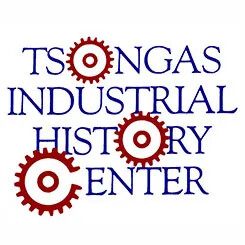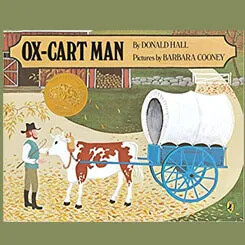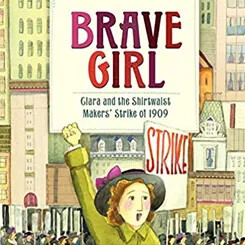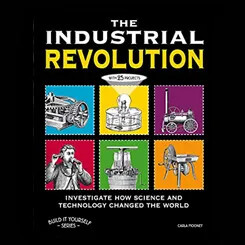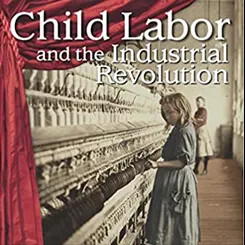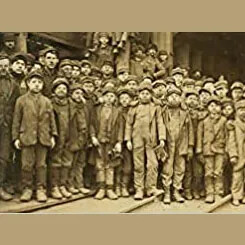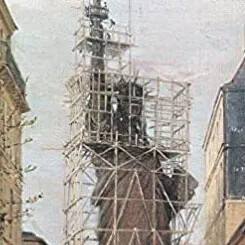Farm Time and Factory Time
How did industrialization change the way people worked in New Hampshire?
For the tens of thousands of workers who left farming and took jobs in New Hampshire factories, industrialization radically changed the nature of work. Agricultural work was physically demanding and labor-intensive, but most people worked on their own farms and made their own decisions about how to spend their efforts. At the mercy of nature and the weather, farm work was organized around natural rhythms, seasonal changes, and family life. And although life on a farm was by no means secure, most farmers in New Hampshire were fairly independent and self-sustaining, even if they and their families were just getting by. There were periods of intense labor on a farm, particularly during planting and harvesting seasons, and periods of relative calm, such as during the winter when many farmers filled their days and earned extra money by engaging in a craft trade, like making furniture.
For workers in the mills, however, life in the factory was very different. Factories and mill yards were enormous—almost cities unto themselves—with vast buildings and huge crowds of workers streaming in when the gates opened each morning. Industrial machinery was intensely noisy, not to mention dangerous, and workrooms were hot and dirty. The work was monotonous, and rigid work schedules were governed by a series of bells. Typical shifts were 12 hours per day, 6 days per week, and the work was not seasonal. It continued year-round regardless of the weather. The idea of a vacation was not introduced until the end of the 1800s, and then usually only for the management class. Vacations did not become widespread among the working class until well into the 20th century.
The nature of work was different in the factories as well. Gone was the variety of tasks needed to run a farm. Workers in factories were generally tied to a small set of well-defined duties. There were skilled and unskilled workers, with men tending toward the skilled jobs, such as mechanics, and women and children more likely to be engaged in unskilled jobs. Men were also far more likely to hold management positions in factories, which naturally elevated their status and their income. For most workers, the work itself was monotonous, with employees undertaking just a few tasks in their part of the production process. Some of those tasks required skilled labor, but as the 19th century progressed, more and more tasks were unskilled, with machinery completing a large part of the production process. Workers were still needed to tend the machinery, though.
Initially the textile mills utilized a new workforce, young women from New England farm towns who often lived in company-owned housing and worked for a few years until they married. They were known as New England mill girls. They arrived in New Hampshire cities from their families’ farms, where their labor was not as valued as their brothers’. Before the production of textiles moved into a factory setting, it was traditionally done at home by young women working with spinning wheels and foot-powered looms. It was hardly surprising then that when much of this work started to move into factories, women followed the work. Textiles were, after all, one of the most important and time-consuming goods to produce, but they had myriad uses at this time, most notably clothing and bedding. Yarn and thread was such a valued commodity in the early 19th century that it was actually used as currency in some places in New Hampshire.
Most of these New England mill girls were in their teens or early twenties, and the experience of leaving home and living without the supervision of their parents was a novel one. Before the advent of factories, these girls would only have left their parents’ household when they married, but suddenly, hundreds of young women were living on their own in growing urban centers. Initially, the factory owners established a very structured environment for the mill girls. They lived in boardinghouses where they were expected to adhere to strict codes of conduct, overseen by a matron, who was typically an older widow with little prospect of remarriage. Meals were provided, and all forms of entertainment, like lectures, concerts, and church services, were carefully screened to ensure moral standards. Factory owners even signed written contracts with the girls’ parents promising to act in loco parentis in exchange for their labor.
Nevertheless, it must have been a heady experience, with the girls having more opportunities to form friendships, meet people outside of their families’ typical social circles, and enjoy a greater degree of freedom than they could have at home. Inevitably, some girls came to bad ends, as the men who came to the growing cities were not always honorable. Girls who had been overly familiar with men lost their jobs and were sent home in disgrace. The working conditions were often unpleasant, as girls were expected to labor six days a week for 10-12 hours per day. Their wages, which were typically just a few dollars a week, were often sent home to their parents. Industrial accidents were common, and little provision was made for the girls’ general health and safety. But on the whole, most girls seemed to feel the experience was a positive one, as their letters home often convinced their friends and sisters to join them in factory work. As mill girls got older, they tended to marry and return to the countryside to raise their families.
As the factories expanded, this labor source became insufficient. There simply weren’t enough New England mill girls to staff the state’s ever-growing roster of factories. Beginning in the late 1840s, the farm girls were replaced by immigrant labor, notably Irish and then French Canadians. The Amoskeag mills, for example, aggressively recruited workers from Quebec, and by 1910, French Canadians made up 35% of their workforce. Many families refused to let their daughters work in the mills once large numbers of immigrants arrived. They believed the immigrants would have a corrupting influence. As immigrants poured into New Hampshire’s cities, the girls from better families left, although many poor New England mill girls had no other choice than factory work. The carefully constructed program created to supervise the mill girls disappeared, though, and factory owners rarely felt responsible for their workers on their off-hours. The mill girls were often left to fend for themselves in crowded, bustling cities.
By the second half of the 19th century, immigrants from all over Europe were flooding into New Hampshire seeking employment in the state’s industries. (For more on the immigrant experience in New Hampshire, see Unit 12: Immigration in the Industrial Age.) Given the poverty of many of these new arrivals, it was not uncommon for entire immigrant families to work in the factories.
If factory work was dangerous and overwhelming for the adult men and women who worked there, it was even more so for child workers. In New Hampshire, as in other industrialized areas of the United States, many children worked in mills and factories, particularly in the textile industry. Although they were at the bottom of the job-pecking order, child labor was seen as necessary to keep the factories functioning smoothly. The children’s size allowed them to crawl under the looms and into machinery to make minor repairs, and their little fingers were much more capable of performing the delicate work involved in the spinning of thread and the weaving of cloth. Children worked as spinners, doffers, or sweepers. Spinners were often girls, and this job involved walking up and down the aisles amidst the machinery to clear away lint and watch for breaks in the thread. If a thread broke, the spinner would fix the string. Doffers were usually boys who would remove the bobbins when they were filled with thread and replace them with empty ones. Accidents were all too common, and many children lost fingers, hands, or arms in the high-powered machinery. There were also health dangers from breathing in the lint floating in the air in most textile factories, which caused a host of lung ailments.
In 1846 New Hampshire became one of the first states to pass a child labor law. This legislation required that child workers complete a certain amount of schooling each year, and subsequent laws regulated the minimum age of employment and maximum working hours for children. However, there were no enforcement mechanisms, and no systematic inspection of factories to ensure that companies were complying with the laws. Many young children continued to work long hours in dangerous conditions, including overnight shifts, at the expense of their health, education, and well-being. In 1908 photojournalist and social reformer Lewis Hine, working for the National Child Labor Committee, traveled throughout New Hampshire as part of his nationwide project to document child labor abuses. Thanks in part to Hine’s work and the efforts of reformers on the state level, including organized labor and women’s clubs, New Hampshire passed a more comprehensive and effective child labor law in 1910.
Like their fellow workers in other industries and other states, New Hampshire’s workers organized formally and informally to improve their working conditions, workplace safety, and wages, although these efforts were sporadic. The first female-led strike in the country occurred at the Dover Cotton Mills in 1828, when roughly 400 women organized for better wages. Women workers in the Manchester Print Works launched a strike in 1855 in response to an increase in the workday. These strikes were unusual, though. The 1880s may have been a period of labor unrest in the United States, but New Hampshire’s industries did not experience a lot of strife during this time. Unions did not make significant inroads in most Granite State industries, and labor disruptions were minimal, with the exception of a short strike in the Amoskeag mills led by the Knights of Labor in 1885.
Many workers derived a strong sense of identity from their employment at a company, an identity that was shaped by and often strengthened family ties. Older family members hired younger relatives, often in the same shop or mill. Entire family groups or immigrants from the same neighborhood worked in the same print shop or weaving room together. This sense of company loyalty was particularly prevalent at the Amoskeag Manufacturing Company. In the 1910s, for example, Amoskeag launched a corporate welfare program that provided a range of benefits to its employees, including social and recreational activities, a dental service, technical training, and a home-ownership program. These efforts were designed to prevent unionization, socialize new immigrant arrivals to industrial work, and instill loyalty to the company. This strong sense of identity and loyalty to the company was a key factor in generally positive relations between management and labor in many New Hampshire industries, and it was not uncommon for employees to spend their entire working life laboring for the same company. It was not until the 1920s, as industries across New Hampshire began to decline, that labor unrest came to the state. (For more on the decline of the mills, see Unit 15: Forging a Modern Identity.)
